Sustainable Ecommerce: What It Is, Why It Matters, and How You Can Build a Sustainable Brand
Deep DiveThis post was originally authored by Lianna Patch in May 2017, and has since been updated in July 2020.
Table of Contents
- Introduction
- What is sustainability, exactly?
- Why is sustainability important for ecommerce and your business
- Reasons to go sustainable
- How your ecommerce business can make the shift to sustainability
- How to develop a marketing sustainability strategy for your business
- Showcase your business’s sustainability and environmental certifications
- Wrap up
Introduction
Today we’re going to talk about what sustainability is: what it looks like in practice—especially in ecommerce—and the real steps you can take to make your business more sustainable (without losing money).
But here’s the thing: You don’t have a choice. Consumers expect all businesses, big, small, brick-and-mortar, and digital to embrace environmental stewardship.
In fact, 81% of global respondents—across gender and age—told Nielsen they agree with the statement: “It is extremely or very important that companies implement programs to improve the environment.”
So how do you make sure your growing digital business can meet buyers’ expectations? This guide will help you understand the basic principles of sustainability for ecommerce and arm you with the tactics to bring it to life for your target customer base in your marketing and email campaigns.
What is sustainability, exactly?
From business models to product packaging, sustainability can take many forms—and all of them will have a huge impact on ecommerce businesses in the coming years.

At its most basic, sustainability refers to an enduring balance that allows humans (and everything else that lives on this planet) to get what we need from the earth without overusing it and overextending its resources.
As sustainability has grown into a Google Trends buzzword, its meaning has gotten a little hazy.
And that’s okay, because it’s nearly impossible to explain what the complex concept of sustainability looks, feels, acts, and smells like in just a few quick sentences. That said, there are a few basic principles.
The five principles of sustainability
Sustainability is a pretty heavy concept, encompassing a multitude of practices across multiple industries with an impact on many aspects of life.
A good framework is Michael Ben-Eli’s five-pronged explanation of sustainability for the Buckminster Fuller Institute. It’s a concrete interpretation that will give you an overview of how sustainability applies across five core domains:
- The material domain constitutes the basis for regulating the flow of materials and energy that underlie existence—in other words, how we use, conserve, regenerate, and manage our resources.
- The economic domain provides a guide for creating and managing wealth—in other words, how countries, companies, societies, markets, and people develop value.
- The life domain provides the basis for appropriate behavior in the biosphere—how people can live in balance with nature.
- The social domain provides the basis for social interactions—every human’s right to self-actualization and freedom.
- The spiritual domain identifies the necessary attitudinal orientation—in other words, the basis for a universal code of ethics.
Now, let’s get to how these sustainability principles ties into ecommerce.
Why is sustainability important for ecommerce and your business
First, let’s set the stage.
Ecommerce is growing at a crazy rate, showing no signs of stopping.
Let’s look at China, for example. Chinese ecommerce ballooned by 24% in 2018 and accounted for 18.4% of consumer retail sales, according to the National Bureau of Statistics of China shared by Digital Commerce 360.
Things in the United States are expanding similarly. In 2018, US ecommerce grew 15%, according to Digital Commerce 360.
But as ecommerce grows, so does its environmental impact.
All those cardboard boxes, plastic packing puffs, and Styrofoam peanuts have to go somewhere, and a lot of the time that somewhere is out to sea or a landfill.
Enter the rise of sustainable ecommerce, an approach to digital business founded on the belief that no matter your industry or product, there are ways to make your ecommerce business more sustainable.
A few brands have taken the lead and set a great example. You’re probably familiar with TOMS shoes, one of the first retailers to publicly pledge to give to those in need. For every pair of TOMS sold, a person without shoes gets a pair. TOMS has expanded its philanthropy to offer other charitable services.
Warby Parker, the eyeglasses purveyor, followed suit with its own one-for-one model a few years later. The company details its sustainability beliefs and efforts in an annual report available online. The report details how the company, which began as an exclusively ecommerce business and now has brick-and-mortar storefronts, sources materials and designs a variety of operations sustainably. The report also explains the value that donating a single pair of glasses provides recipients and their communities.

The company also regularly includes a link to information about its “Buy a Pair, Give a Pair” program in its emails, often like this, where the tease is included with other content along the email’s footer:
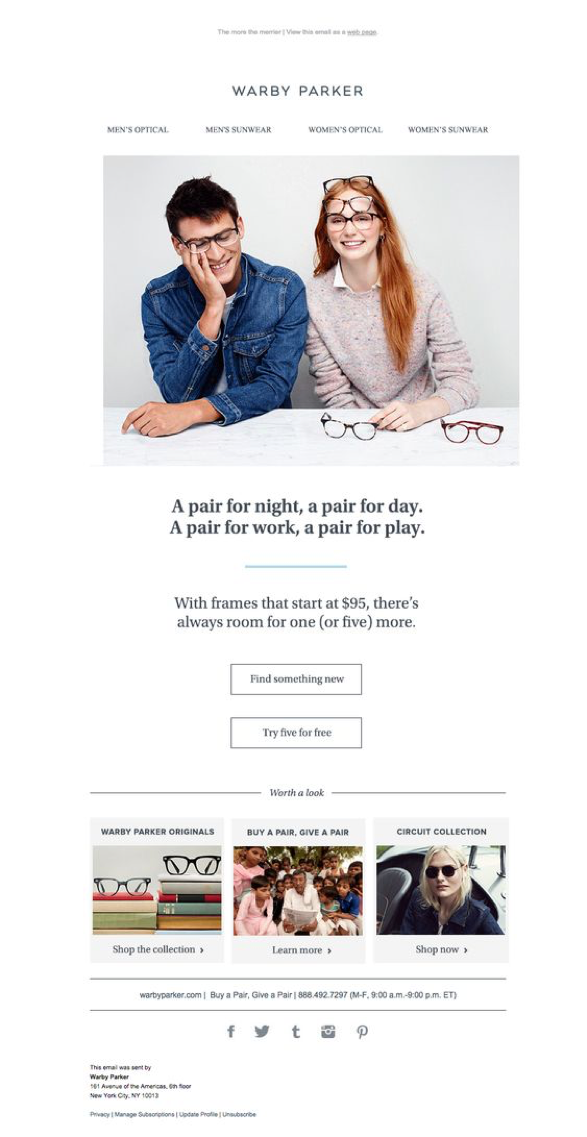
These days you can find online retailers committed to sustainable principles all over—from shoes to eyeglasses and everything in between. There are so many real steps that you can take to make your ecommerce business just a little bit more sustainable, just a little bit at a time.
Here’s how some ecommerce shops define sustainability
Some ecommerce business owners consider sustainability a guiding practice that affects all of their business decisions.
We reached out to a few of our customers—ecommerce businesses that prioritize philanthropy and environmentally friendly practices—to get a practical perspective on how to embrace environmentally friendly ecommerce.
We asked two questions:
- How do you define sustainable?
- What actions does your business take to give back or do good?
The answers generally focused on three areas:
- The business’s ability to make a profit and stay in business
- Use of fair-trade materials and fair labor practices
- Philanthropic outreach or donation as part of the business’s core mission
George Brooks of Banded, which sells headbands and other accessories, responded that his business defines sustainable as “financially viable, as cost-efficient as possible, with changing and growing product lines and multiple avenues of distribution.”
Interestingly enough, he didn’t mention philanthropy outright—but every purchase of a Banded product donates three meals to a child in need.
Eric Gantz at Verena Street Coffee said, “I define sustainable as the utilization of business practices that do not negatively impact the future of your industry, product, or company.”
Verena Street sources its beans from 100% Rainforest Alliance Certified farms, which pledge to protect not only the wildlife and environment around them but farmers and their families, too.
And Judith Treanor at Temples and Markets, which sells jewelry hand made by artisans and cooperatives in Southeast Asia, replied that she defines sustainable as simply “enduring and kind to the planet.”
Your business can define its own version of sustainability. Let’s dive into how you can get started.
Reasons to go sustainable
Of course there’s the belief that people are inherently good and care about the planet and their fellow humans. But there are also a few real-talk, “take it to the CFO” reasons for emphasizing sustainability in your ecommerce business.
Let’s cover a few reasons to go sustainable.
1. You’ll eventually be required to do it.
If you’re not required to monitor or mitigate your business’s environmental, economic, or social impact already, you probably will be soon.
Remember how we talked about China earlier? Ironically, the country’s online shopping habit—which poses an intimidating environmental threat in terms of sheer tons of packaging waste and CO2 emissions—sees big spikes on days when pollution haze makes it too dangerous to go outside.
As a result, the government has continued to expand regulations tied to sustainability targets.
Clearly, we’re not doing a great job addressing the environmental impact of our spending by ourselves. Both policy analysts and environmental activists agree that for things to really change, tougher regulations will have to be imposed.
So, before the government steps in, invest some time and energy in investigating sustainability.
2. It can save you money.
You might know that adding too much packing material to a shipment can add cost and weight, turning your operations into a losing equation for both your bottom line and the planet.
But on the flip side, adding too little packing material can result in items or packages being damaged during delivery, which leads to a higher rate of returns—bad for you, your customer, and the environment.
“Properly packaged goods have a better chance of arriving intact, reducing the number of returns and the overall environmental footprint,” points out UPS. “When a shipment is packed correctly and arrives undamaged, replacement goods aren’t needed and additional transport isn’t required to replace the item.”
More and more businesses are finding a balance between doing good and making bank. In fact, an overview by the Harvard Business Review shows that prioritizing sustainability in business won’t kill your profits.
3. It can help your brand.
More and more, customers care about environmental stewardship and socioeconomic justice. And they’re starting to show it in online purchases.
This is especially true for millennials. They ask more questions about the businesses they buy from and look for brands that align with their values.
Even if you’re not trying to attract millennials, beginning to focus on a sustainable model shows consumers that you’re more than just a place to buy things—you’re a brand that stands for something.
And being a brand that stands for something means customers will stay loyal to you longer. They’ll tell their friends about you. And they might even pay more.
Bottom line: Whether you choose to apply the principles of sustainability to your product materials or sources, your commitment to social equality or justice, your impact on the environment, or the philosophy of your business, implementing sustainable practices is a no-brainer for your ecommerce business.
How your ecommerce business can make the shift to sustainability
First, examine the areas of your business where it would be easiest to make a change.
For example:
- If you’re shipping products, can you source recycled boxes or offer a shipping discount for methods that use less carbon?
- If you have wiggle room in your margins, can you pledge a monthly recurring donation to a reputable nonprofit or charity? (You can search most charities and find out how they spend their money at CharityNavigator.org.)
- If you source materials from suppliers, can you work with more fair-trade organizations?
From soul-searching to slower shipping, here are a few more ways you can begin to include the principles of sustainability in your business.
1. Update your philosophy or ethos.
Deciding to change the way you run your business is the first step. Along with that decision, you can begin to practice transparency.
Transparency is one of the easiest ways to become a more sustainable business, whether you’re a high-volume product retailer or a software as a service (SaaS) business that doesn’t ship products.
By emphasizing honesty and clarity about your practices, processes, and people, you can earn buyer trust and inspire competitors to do better. In practice, transparency essentially stems from the idea that if we all work together, we’ll accomplish more.
Dr. Jonas Salk invented the first polio vaccine and did not patent it so it would stay available to everyone who needed it. This is an excellent example of how transparency can contribute to the greater good.
Some popular companies have led a push for transparency, including the social media platform Buffer, which makes its salary information, revenue, and other generally private information public on this transparency dashboard.
The Buffer team also regularly publishes thoughtful blogs about how the company works and what it’s doing to improve.
Groove and Baremetrics are two other SaaS businesses that open their inner workings to the public, and more founders are following suit. But in ecommerce, transparency is still radical, according to Retention Science.
Want to be in the vanguard of transparent ecommerce businesses? One of the most obvious places to reveal what’s going on beneath the surface is on costs and pricing.
One potential reason for ecommerce’s lack of pricing transparency is that retailers are afraid to reveal the markup on their products. Another is that consumers simply haven’t had the ability, platform, or drive to demand this type of information before now.
Nearly 20 years ago, the Harvard Business Review named four challenges that cost transparency poses for businesses, chiefly the tendency of transparent cost pricing to damage sellers’ margins. The article also suggests that cost transparency weakens customers’ loyalty to brands, since buyers will naturally seek out the lowest price for items of similar quality.
But HBR failed to consider that sellers can use cost transparency to build customer loyalty. Take Everlane, which coined the catchphrase “radical transparency” and was among the first ecommerce retailers to reveal how its pricing works in handy infographics beneath its products.
Here’s how Everlane breaks down pricing for its Cotton Collarless Belted Shirtdress:
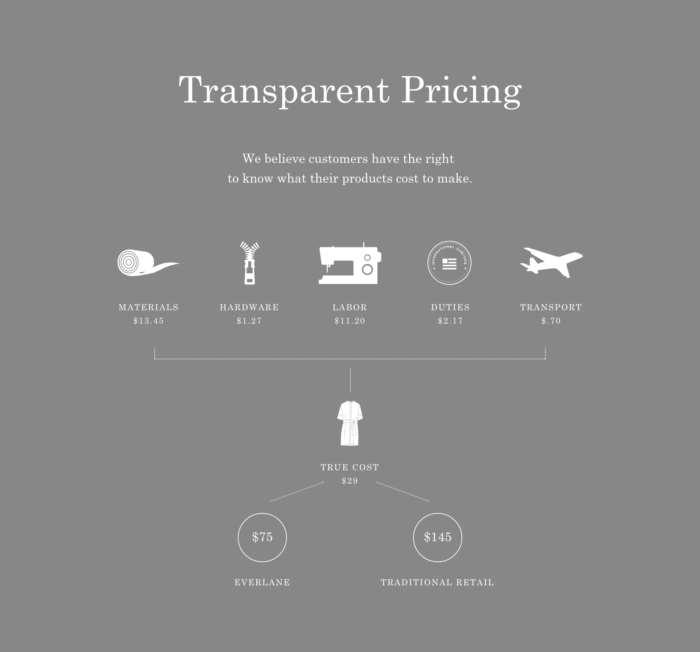
And the company doubles down on its messaging in its recycled packaging.
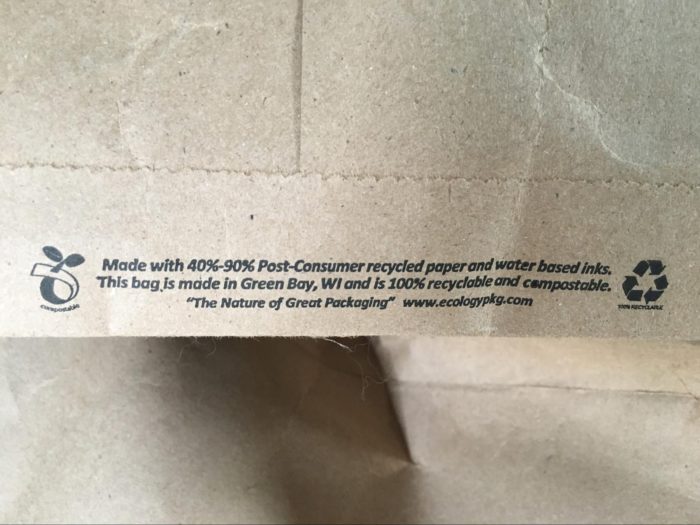
Even the cards it includes in each purchase show more about their commitment to transparent pricing:
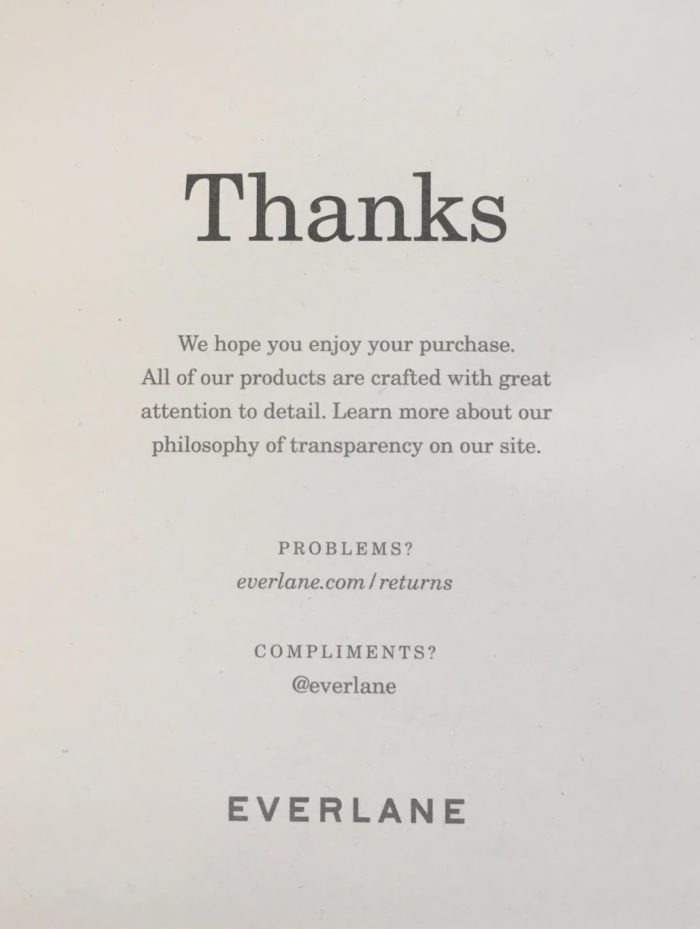
Shoemaker Oliver Cabell takes the same approach on its product pages, detailing the source materials of shoes like its Phoenix, though it eschews infographics:
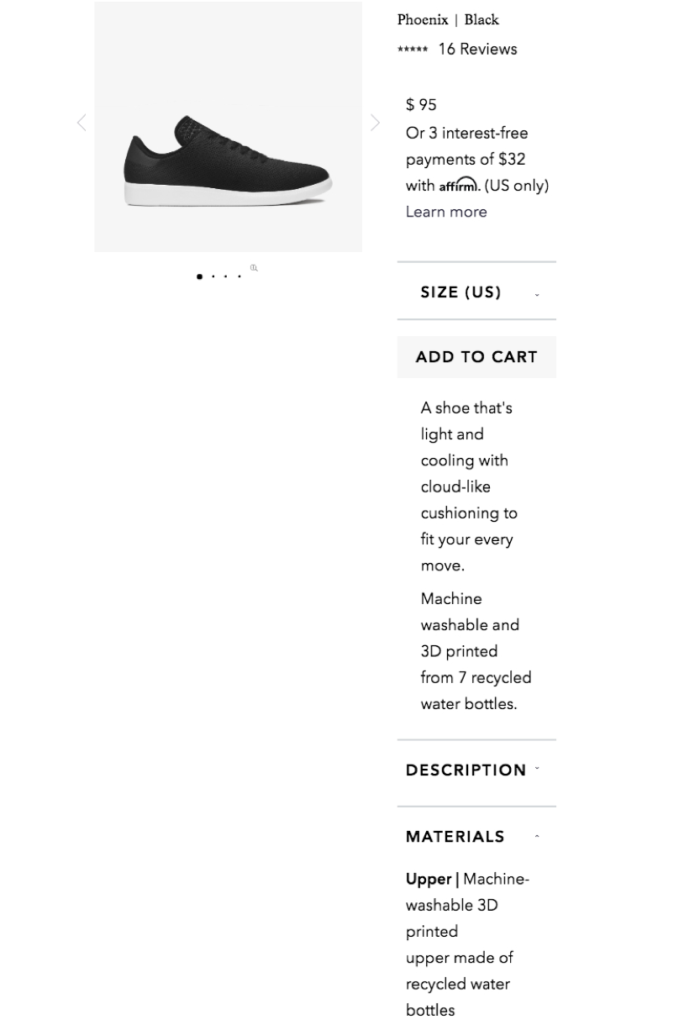
Assuming you’re not gouging your customers, you might reveal how and where your business makes a profit—and reap your buyers’ love and loyalty in return.
2. Take a stand on a social issue.
If you care about a specific issue, you and your business can do something about it. Here are a few ways to put your money where your manifesto is:
- Hire differently abled people. Business owners in the United States can benefit from tax credits and other programs that offset related costs, such as installing a wheelchair ramp at your office.
- Commit to elevating the voices of minorities, like Ikuzi Dolls, which sells dolls with shades of brown and black skin.
- Hire veterans, like Bottle Breacher. This is another example where you can gain tax credits as US business owners.
- Promote the belief that every size of woman is beautiful and worthy, like Hello Holiday.
- Hire felons or criminal offenders. Again, tax credits for US business owners.
You can also intentionally work with producers or suppliers in areas with struggling economies, which can be cost-effective for you and can offer a quality-of-life improvement for makers or workers in that area.
One shoemaker, Nisolo, is founded on a commitment to supporting local artisans. The shoes are fairly expensive, but fast fashion comes at a cost, too. The company shares its mission to deliver ethical fashion choices on its vision page:

Also consider Combat Flip Flops, which manufactures its products in Afghanistan to empower families in that war-torn country. Or DharmaShop, which works with artisans in small villages in Nepal.
3. Update your physical location to be environmentally friendly.
Offset your carbon footprint with small changes.
Set the air conditioning a couple of degrees higher in the summer. Install low-flow plumbing fixtures. Replace incandescent bulbs with LEDs or fluorescents. Plant a green roof. Install motion-sensing lights. And stop printing some things.
The list of ways to reduce the environmental impact of your physical location, whether it’s a small shop or a shipping facility, is endless. And it’s not as much of a pain in the wallet as it might sound.
For instance, LED bulbs last much longer than their incandescent counterparts. Though they might cost more upfront, you’ll save in the long run.
Plus, taking steps to reduce your physical location’s environmental impact might earn your building a certification like LEED. Certifications like this can increase your building’s value and longevity, safeguard your employees’ health and comfort, and mitigate impending obsolescence.
4. Reduce packaging waste and the environmental impact of shipping.
Packaging trash is a huge issue for ecommerce, and it’s only going to get worse. Unless we take steps to fix it now.
You’ve probably already investigated many types of shipping materials and options. But have you considered doing away with box in a box model, like Allbirds?
The maker of increasingly ubiquitous merino wool running shoes says its unique box design uses “90% post-consumer recycled cardboard that serves as a shoebox, shopping bag, and mailer all in one.”
Because so many items are shipped in different ways—from tiny items to huge machinery and direct-to-consumer to wholesalers and distributors, there’s no single shipping solution that will work across the entire ecommerce industry.
But here are some things you can try:
- Switch to eco-friendly packaging options, such as recycled boxes and inflatable packaging.
- Bundle goods instead of shipping in multiple boxes.
- Offer discounts if a customer waives the ability to return a product.
- Offer slower shipping options for store credit or rewards, like Amazon.
- Switch to emailed receipts instead of paper packing slips.
- Contribute to a carbon offset program, like this one from the Nature Conservancy (but do your research first—especially if you’re buying offsets instead of contributing to a nonprofit—to make sure that the lion’s share of your cash is going toward offsetting activities).
5. Start a donation program.
We’ve already talked about TOMS, Warby Parker, and other lesser-known businesses with donation models.
Whether you’re donating in-kind products, like Warby Parker, giving your time, or giving in another way (like Banded2Gether’s meal program, or Inkkas’ OneShoeOneTree project, or Zappos’ program to ship gently used shoes and clothing to those in need), you can probably find a creative way to give.
And if you have questions or want help, you can always hire a consultant.
6. Work with a local sustainability organization.
Your city or town probably has two, three, or more environmental or philanthropic organizations that would like to collaborate with your ecommerce business to become more sustainable.
Don’t know of any? You can also find opportunities, organizations, and ideas on sites like Idealist.org and GreenForAll.org.
Officially decided to make a shift toward sustainable ecommerce? It doesn’t matter if no one knows about it.
To spread the word and encourage other ecommerce businesses to investigate sustainable practices, you have to market your ecommerce sustainability.
How to develop a marketing sustainability strategy for your business
Once you decide how to approach sustainability in your business, it’s time to share the news with your visitors, customers, and investors.
No matter where you place the copy you’ve written about your business’s commitment to sustainability, your marketing sustainability strategy should be clear, straightforward, and uplifting.
Leave no room for braggadocio or self-celebration. And use proof points, such as your quantifiable impact at the end of the first year of your sustainability program.
Here’s how to clearly and effectively convey your sustainability approach in your marketing efforts, from your homepage value proposition and branding down to your cart microcopy.
How to include sustainability in your branding
First, you’ll want to consider how your branding might need to change to convey your new approach to current and future customers.
Why update your branding? Along with clearly conveying what you sell, your brand should reflect your business values and practices.
If those values are changing, you should probably make that change clear in your branding from here on out. Especially if it will shake up your pricing model, shipping abilities, or supplier or vendor relationships.
But, by the same token, people appreciate history and continuity. If your branding has helped build trust with your customers, you don’t want to take a rebrand too far. You want to maintain the brand equity you’ve built—but you want people to recognize you later on for your move to become greener too.
That’s why rebranding can be a delicate balance, especially for well-known or long-standing brands.
Take a rebrand too far, and people will revolt. Don’t rebrand, and people might be confused when you try to explain your changes.
Shifting your branding might be as drastic as changing your company name or location or as subtle as updating your brand palette to include green, like Clorox did with its Green Works line.
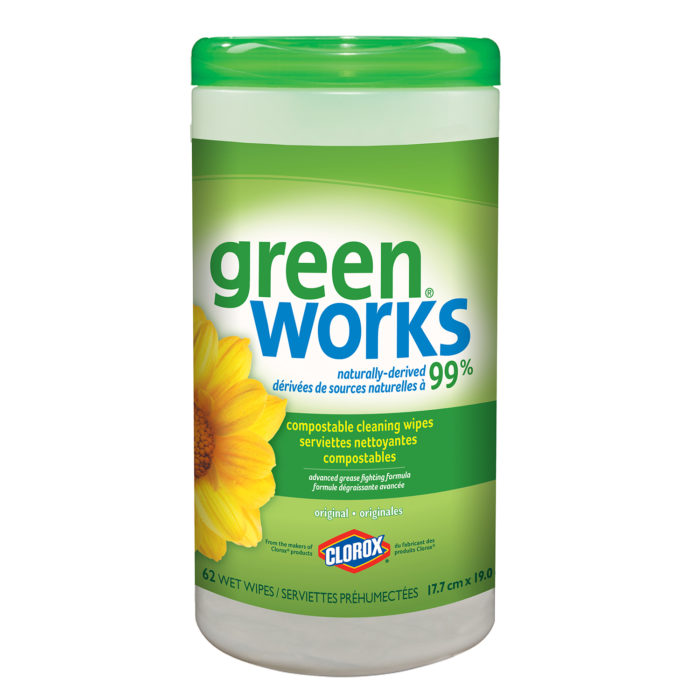
You might be interested to know that one study of consumer perception of logo colors found that blue was actually considered “greener” than green in conveying environmental friendliness and ethical behavior.
If you prefer, you can stick to sharing the news in your copy and messaging. Your unique value proposition is the best place to start. Since your UVP copy should include what you do, for whom, and what makes you different, you might consider mentioning your sustainable practices.
Many businesses use their UVPs as a homepage headline, so visitors know instantly what the website they’ve just landed on is about.
If you’re trying to figure out your UVP, keep it simple. What do you sell? How are you different from other companies that sell it?
You can also update your about page to explain your philosophy and approach to sustainability.
Banded, for instance, explains on its “Giveback” page how each accessory purchase from its site provides meals for impoverished children:

Showcase your business’s sustainability and environmental certifications
Verena Street Coffee, also mentioned earlier, sells coffee only from Rainforest Alliance Certified farms.
This certification requires farms to pass regular audits across a range of sustainability metrics, including protecting waterways and animal habitats and providing housing, schools, and medical care for the families of its workers.
Verena Street Coffee’s “Responsible Sourcing” page explains how its Rainforest Alliance Certified coffee benefits the planet and the people who produce it.
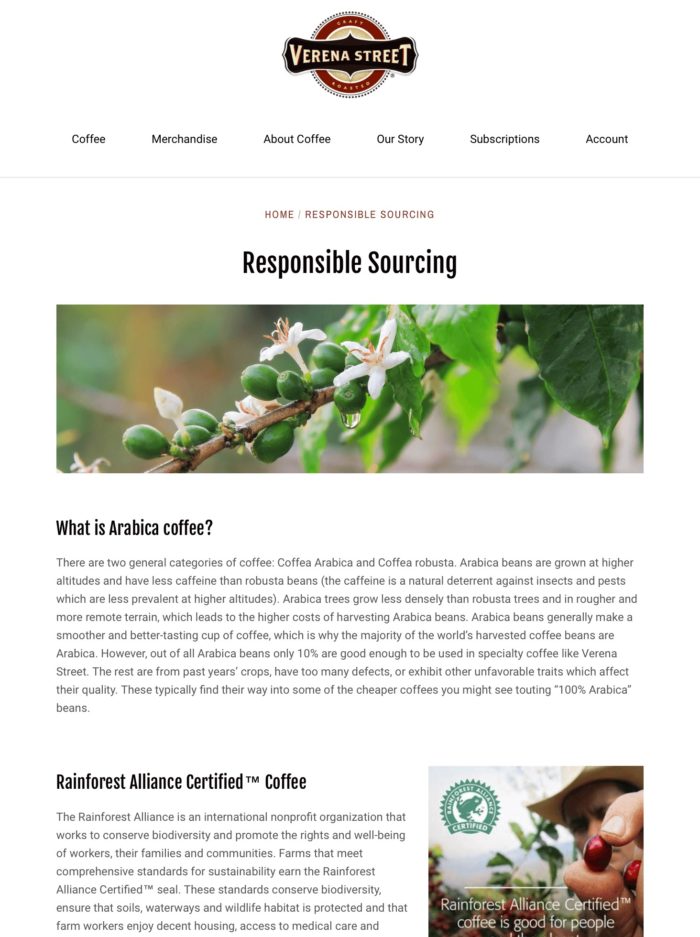
Remember that proof? You’ll build trust with consumers by quantifying your impact year over year—and the more concretely you can do that, the more trust you will build.
Shoemaker Nisolo put together a downloadable “Impact Report” that establishes its business model in context with the fashion industry as a whole and details the company’s impact by the numbers. It also sends new customers a “welcome email” that shares it sustainability story:

A good rule of thumb is to mention sustainability where it makes sense and can benefit your conversions—because sometimes making your customer feel like an altruist could be the difference between a purchase and an abandoned cart.
With that in mind, you should consider placing sustainability messaging inside your store’s purchase funnel.
Where might prospects on the path to purchase be encouraged by hearing about your company’s practices or philosophy? And where do you risk distracting them with that information?
For instance, you can let prospects know on the product page level exactly how their purchase price is allocated.
Let’s go back to Everlane for an example. The brand includes short copy on its “Choose What You Pay” overstock items that reveals the exact overhead that each price covers. Look for it on the right side, just above the prices.

You can also test click-trigger copy that mentions sustainability, since making your customers feel good about their purchase decisions can help them overcome barriers to buying.
And remember, clear is more important than clever, especially in ecommerce email copy.
Don’t forget: If your message gets muddy at any point, it’s time to refocus. At the end of the day, your site and your emails should keep the focus on your product and its benefits to your customers.
Let’s get back to one last way to include sustainability in your marketing: Take advantage of the green calendar.
In case you thought Arbor Day and Earth Day were alone in the world, it turns out there are more than 50 earth- and environment-related holidays.
Do customers buy more goods from sustainable businesses on these days? We looked at the sales of five customers who consider their businesses “sustainable” on five major environment-related days (World Wetlands Day, Earth Day, Arbor Day, World Environment Day, and the International Day of Climate Action).
That’s five businesses, five particular days of the year.
Three of those five days turned out to be among their 30 highest-grossing days of the year. They weren’t the top sales days, but they were popular.
What we found may not be meaningful, especially considering our small sample size and that some of these businesses are in different time zones (thus the “holiday” might actually fall on a different day). But it’s food for thought—and may signify an opportunity for sustainable ecommerce retailers to get more attention throughout the year.
If you’re looking for insights like this in your own sustainable business, review your last year of sales for date-based insights. Are there any spikes? Did you just so happen to sell out of your inventory on Desertification Day? (June 17, for those wondering yet unwilling to click.
Wrap up
Just as physical store owners are being urged not to think of ecommerce as an adjunct to their business, you should walk away from this article thinking of sustainability as a core component of your business.
Even if you decide not to reveal your pricing structure, consider some of the creative shipping options detailed or the clever ways to market and engage your would-be customers based on your sustainability values.
So many ecommerce brands walk their talk, from the few listed in this article to the hundreds more who are quietly doing what’s ethically and morally right without any recognition. You could be the next one.
What are you going to do to make your ecommerce business more sustainable? Let the ideas begin.
And when you’re ready to spread the word about your new sustainability initiatives, email is the perfect channel to let your customers know.
From welcome emails to re-engagement campaigns and beyond, we seamlessly integrate with your ecommerce platforms—BigCommerce, Shopify, and WooCommerce—so you’ll have all the features you need to exceed your goals.
Get up and running with CM Commerce right now. Just type in your store URL here and see data from your shopping platforms in less than 24 hours.